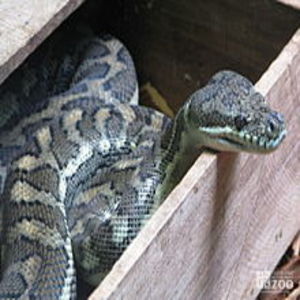Carpet Python
[Morelia spilota]

The Carpet Python's length can be up to 13 feet, but averages about 6.5 feet, with females being slightly larger than males. The body is typically some shade of beige or brown. A blackish or gray pattern may consist of blotches, cross-bands, stripes, or indistinct combinations of the three. The common name alludes to the ‘oriental carpet’ effect. Regional color phases exist and may include bright yellow, gold, rust, and clear grays in the pattern. Three subspecies have been recognized. One, Morelia spilotes spilotes, or Diamond Python, is usually olive black above, with cream or yellow spots on many of the individual scales forming an indistinct pattern of diamond shapes. The underside is cream or yellowish, variegated with dark gray. Morelia spilotes variegata has an enormous variety of colors and patterns, the ground color being light to dark brown marked with blackish (sometimes lighter centered) variegations. Morelia imbricata is a large, robust animal with a dark, brownigh general appearance. The underside is cream or yellowish. The upper surface of the head is composed mainly of small, irregular scales rather than the large symmetrical scales typical of most other pythons, and the head itself is more distinct from the neck.
Location: Education Animals
Share:
Range
The Carpet Python's range is Australia (except Western and extreme Southeastern), New Guinea.
Habitat
The Carpet Python inhabits a wide variety, from humid rainforests to dry, semi-desert plains.
Conservation Status
Least ConcernPrimary Threats
Gestation
Gestation takes an average of 40 days.
Litter
Up to 18 eggs
Behavior
Carpet pythons are mainly nocturnal and semiarboreal in habits. They prefer heavily wooded areas, but can be found in a variety of habitats as well. They are excellent climbers. Prey consists of small mammals, birds and lizards. Some use burrows of other animals, while others live in hollow limbs. They are non-venomous, and kill by constriction, suffocating their prey. Most pythons have heat-sensitive pits in the lower lip scales used for detecting warm-blooded mammals and birds. Their recurved teeth hold the prey securely while it is being swallowed. Moveable bones in the skull and a distensible skin enable pythons to eat food items larger then their own girth. They then fast for long periods. They frequently feed on Brush-tail Possums.
Reproduction
Short spurs (vestigial hindlimbs) are present on each side of the cloaca. The male Carpet Python uses these to stimulate the female during breeding. Females can generate enough heat by muscle contraction to elevate body temperature (referred to as themogenesis.) and thereby brood their eggs during the incubation period. Pythons are the only Australian snakes known to remain with their eggs. Hatchlings are approximately 12 inches long.
Wild Diet
Mammals and birds
Zoo Diet
Mice and Chicks
